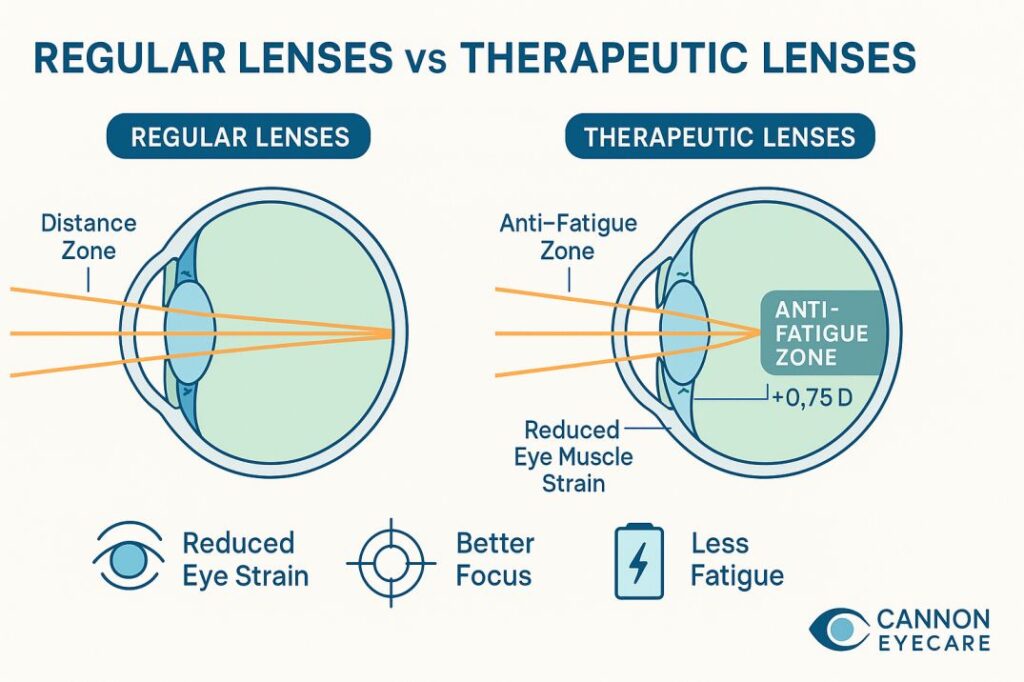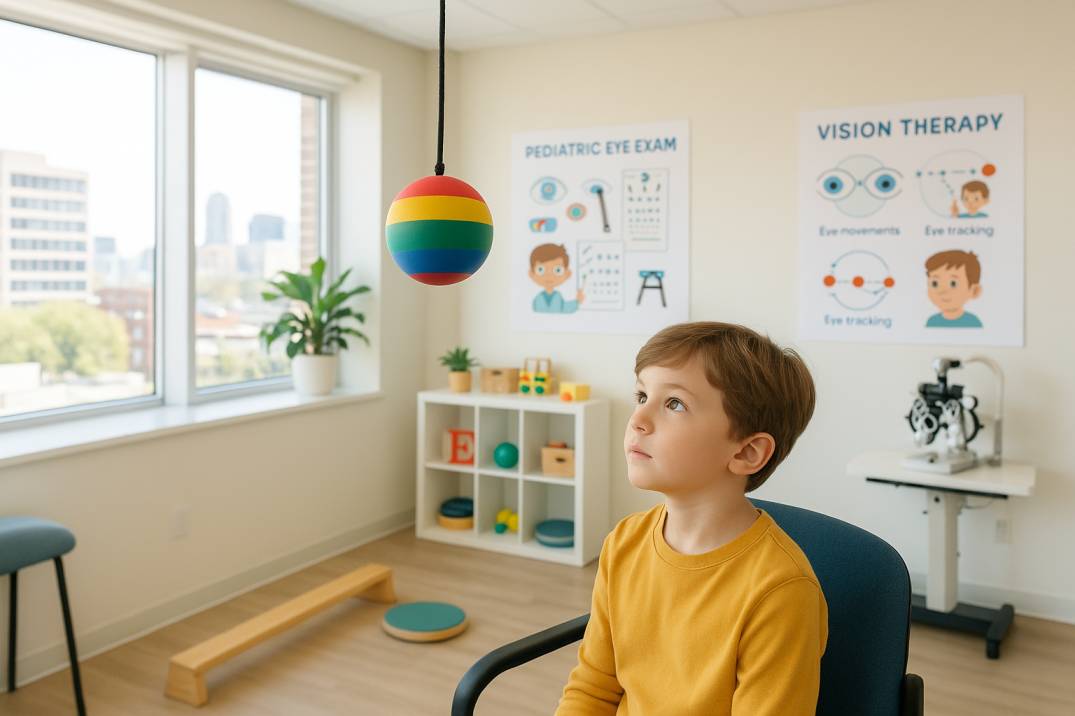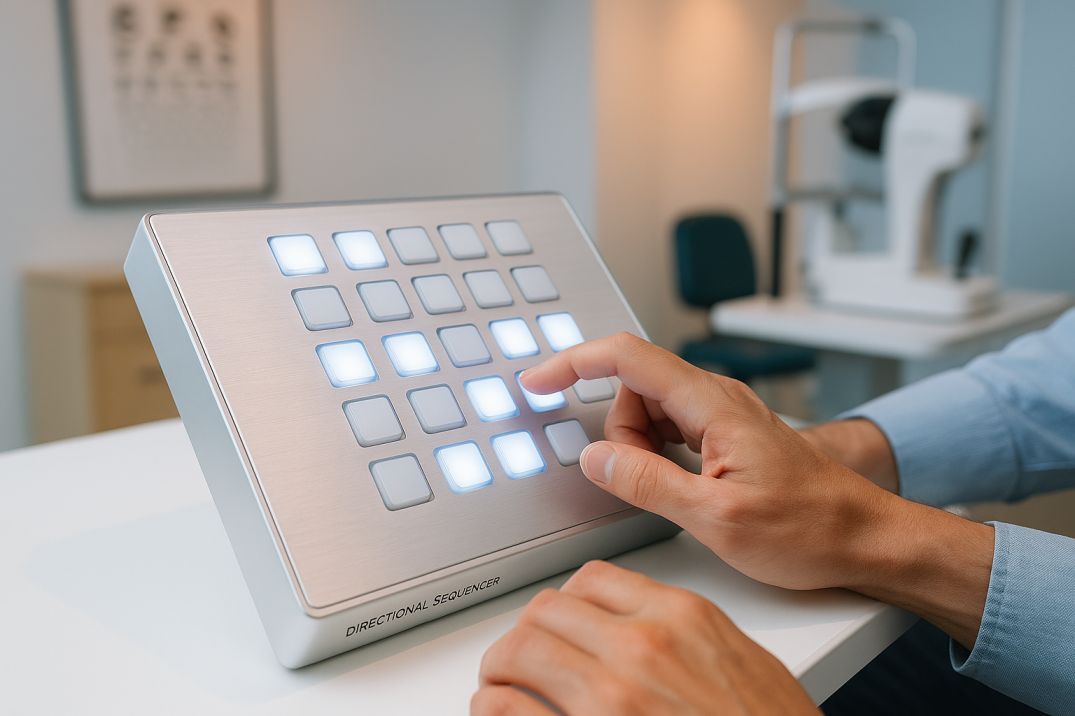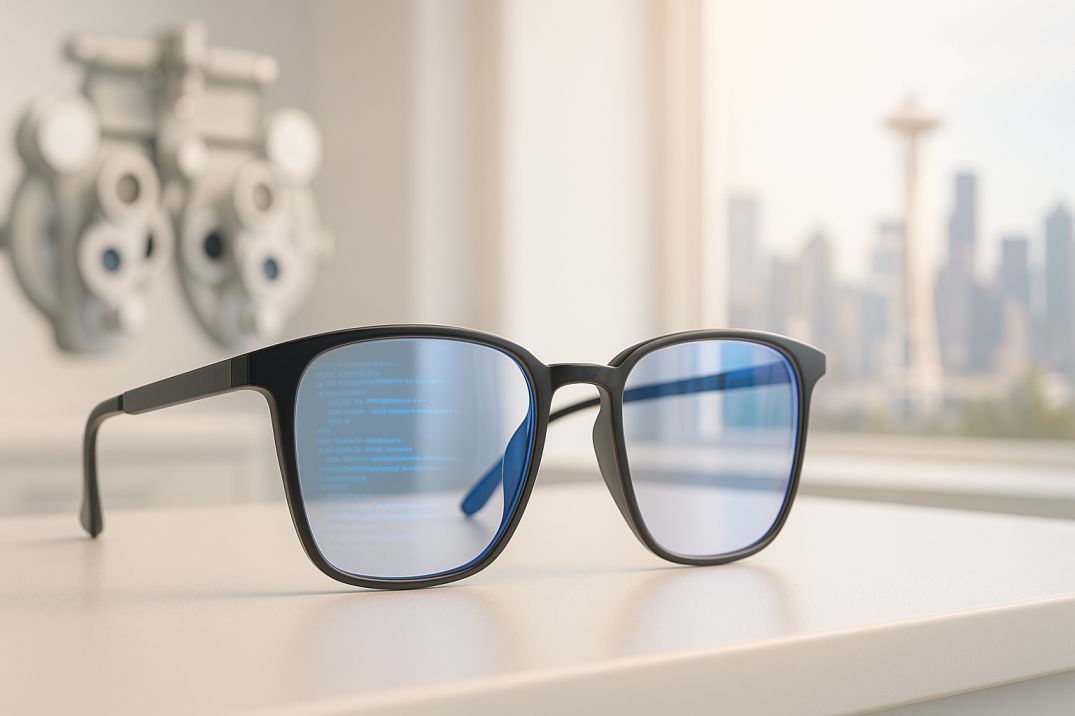Therapeutic Lenses for Digital Eye Strain Relief
What Are Therapeutic Lenses? Understanding the Science Behind Visual Comfort
Therapeutic lenses represent a revolutionary advancement in eye care, specifically designed to address the growing epidemic of digital eye strain while providing medical-grade treatment for various ocular conditions. At Cannon EyeCare, we specialize in these cutting-edge lenses that combine vision correction with therapeutic benefits, making them essential tools for modern eye health in Seattle.
Types of Therapeutic Lenses Available at Cannon EyeCare
Anti-Fatigue Lenses (Computer Vision Lenses) These innovative “mini-progressives” feature a slight magnification boost in the lower portion of the lens, typically ranging from +0.37 to +0.75 diopters. Popular therapeutic lens brands include:
- Essilor’s EyeZen (optimized for smartphone users)
- Nikon RelaxSee (ideal for computer professionals)
- Hoya Sync III (balanced for multiple digital devices)
- Zeiss Digital lenses (customized for working distance)
These therapeutic lenses help your eye muscles relax during near-vision tasks, significantly reducing the constant refocusing effort required when viewing digital screens throughout the workday.
Therapeutic Contact Lenses for Advanced Treatment Our Seattle eye care specialists offer various therapeutic contact lens options, including:
- Bandage lenses for corneal protection and healing
- Drug-eluting lenses for sustained medication delivery
- Scleral lenses for severe dry eye management
- Smart contact lenses for monitoring eye pressure and glucose levels
Blue Light Filtering Lenses Designed specifically to reduce exposure to high-energy visible (HEV) light emitted by digital devices, these therapeutic lenses may help improve sleep quality and reduce eye strain. While recent studies show mixed results on their effectiveness, many patients report improved comfort during extended screen use.
Tinted Therapeutic Lenses for Light Sensitivity Specialized therapeutic tints like FL-41 (rose-colored) can help reduce light sensitivity and migraine triggers, while specific tints address photophobia and visual stress conditions common among Seattle professionals working in bright office environments.
The Digital Eye Strain Epidemic: Why Seattle Professionals Need Therapeutic Lenses from Cannon EyeCare
Understanding Computer Vision Syndrome (CVS)
What is computer vision syndrome? Computer Vision Syndrome (CVS), also known as digital eye strain, affects up to 66% of computer users, with recent studies showing prevalence rates between 50-90% depending on usage patterns. For Seattle’s tech-savvy workforce, this percentage is likely even higher.
Common CVS symptoms include:
- Eye fatigue and strain
- Dry, irritated eyes
- Blurred vision (especially after screen use)
- Headaches behind the eyes
- Neck and shoulder pain
- Difficulty refocusing between distances
The Science Behind Screen-Related Eye Strain
Why do screens cause eye strain? Digital screens create unique challenges for our visual system that traditional printed materials don’t present. Unlike printed text with well-defined edges, screen pixels are brightest at the center and diminish toward the edges. This forces our eyes to constantly work harder to maintain focus, leading to the “resting point of accommodation” phenomenon, where eyes naturally drift to a less focused state.
Key factors contributing to digital eye strain:
- Reduced blink rate (approximately 60% decrease during screen use)
- Increased tear evaporation leading to dry eye symptoms
- Blue light exposure disrupts circadian rhythms
- Poor screen positioning and ergonomics
- Uncorrected vision problems amplified by screen use
How Therapeutic Lenses Work: The Technology Behind Better Vision
Anti-Fatigue Lens Design and Engineering
How do anti-fatigue lenses reduce eye strain? Anti-fatigue lenses incorporate sophisticated optical engineering principles. The upper portion maintains your distance prescription, while the lower section features a graduated increase in plus power (typically +0.75D). This design mimics the natural accommodation process, allowing your eyes to focus more easily on near objects without excessive muscle strain.
Advanced manufacturing features:
- Digital surfacing technology for precise optical zones
- Customization based on individual visual demands
- Progressive power distribution for seamless transitions
- Optimized corridor design for maximum comfort
Advanced Coating Technologies for Enhanced Performance
Modern therapeutic lenses at Cannon EyeCare feature multiple specialized coatings:
- Anti-reflective coatings: Reduce screen glare by up to 99%
- Hydrophobic treatments: Repel moisture and fingerprints for clearer vision
- Blue light filters: Selectively block harmful wavelengths while preserving color perception
- Scratch-resistant hardcoats: Ensure long-lasting clarity and durability
- UV protection: Shield eyes from harmful ultraviolet radiation
Drug-Delivery Systems in Contact Lenses
How do therapeutic contact lenses deliver medication? The latest therapeutic contact lenses can deliver medications directly to the eye, providing sustained release over days or weeks. Recent innovations include:
- Vitamin E barriers that control drug diffusion rates
- Molecular imprinting techniques that enhance drug binding
- Smart polymer systems that respond to eye conditions
- Nano-encapsulation technology for precise drug delivery
Benefits and Applications: Transforming Your Visual Experience at Cannon EyeCare
Immediate Comfort Improvements
How quickly do therapeutic lenses work? Patients at Cannon EyeCare typically notice reduced eye strain within the first few hours of wearing therapeutic lenses. The slight magnification in anti-fatigue lenses allows eye muscles to relax during near-vision tasks, while specialized coatings reduce glare and improve contrast.
Immediate benefits include:
- Reduced eye strain during computer work
- Less frequent headaches
- Improved focus and concentration
- Decreased neck and shoulder tension
- Better overall visual comfort
Long-Term Vision Health Protection
Do therapeutic lenses protect long-term eye health? Yes, therapeutic lenses provide several long-term benefits that support overall eye wellness:
- Reduced accommodative stress on focusing muscles
- Improved tear film stability with certain lens designs
- Better posture by reducing the need to lean forward to see screens clearly
- Enhanced productivity through reduced visual fatigue
- Prevention of digital eye strain progression
Specific Medical Applications
Pre-Presbyopia Management For adults in their 30s and early 40s experiencing early signs of presbyopia, therapeutic lenses can delay the need for reading glasses while providing immediate symptom relief.
Post-Surgical Recovery Therapeutic contact lenses play a crucial role in corneal healing after procedures like LASIK, PRK, or cataract surgery, providing protection and promoting faster recovery.
Dry Eye Disease Treatment Scleral lenses create a tear-filled vault over the cornea, providing continuous hydration for patients with severe dry eye conditions like Sjögren’s syndrome or chronic GVHD.
Who Needs Therapeutic Lenses? Identifying the Right Candidates
Primary Candidates for Therapeutic Lenses
Seattle Tech Professionals and Knowledge Workers: Are you a software developer, data analyst, or digital marketing professional? If you spend 4+ hours daily on computers, tablets, or smartphones, therapeutic lenses can significantly improve your comfort and productivity. This is especially relevant for Seattle’s thriving tech industry professionals working at companies like Amazon, Microsoft, and local startups.
Students and Academic Professionals
College students and researchers who engage in extensive reading and computer work often benefit tremendously from the accommodation relief provided by anti-fatigue therapeutic lenses. Internal Link Opportunity: University Village location for students
Pre-Presbyopic Adults (Ages 35-45) Adults beginning to experience difficulty with near vision can use therapeutic lenses as an effective bridge before transitioning to progressive lenses. This age group represents ideal candidates for early intervention.
Medical Candidates for Therapeutic Contact Lenses
Post-Surgical Patients Who needs therapeutic contact lenses after surgery? Patients recovering from corneal surgeries, including LASIK, PRK, or corneal transplants, often require therapeutic contact lenses for optimal healing and comfort during recovery.
Chronic Dry Eye Sufferers Individuals with conditions like Sjögren’s syndrome, chronic GVHD, or Stevens-Johnson syndrome may benefit significantly from scleral therapeutic lenses that provide continuous corneal hydration.
Corneal Irregularity Patients Those with keratoconus, corneal scarring, or other irregularities often achieve dramatically better vision with specialized therapeutic contact lenses designed for irregular corneas.
Choosing the Right Therapeutic Lenses: A Personalized Approach at Cannon EyeCare
Comprehensive Assessment Process
At Cannon EyeCare, your eye care provider conducts a thorough evaluation of your specific visual tasks, including screen distance, working posture, and duration of near-vision activities. Different therapeutic lens designs work better for different usage patterns, and our Seattle optometrists ensure optimal matching through:
Visual Demands Analysis
- Screen distance measurements and optimization
- Working posture evaluation and recommendations
- Task duration assessment for optimal lens selection
- Environmental lighting analysis
- Ergonomic workspace consultation
Ocular Health Evaluation at Cannon EyeCare
Our comprehensive eye exams assess tear film quality, accommodation ability, binocular vision function, and any underlying conditions that might benefit from therapeutic lens intervention. Our state-of-the-art diagnostic equipment ensures precise therapeutic lens recommendations.
Advanced diagnostic testing includes:
- Tear film analysis using advanced imaging
- Accommodation and convergence testing
- Binocular vision assessment
- Digital retinal photography
- Corneal topography for contact lens fitting
Popular Therapeutic Lens Options Available
For Digital Device Users:
- Essilor EyeZen (optimized for smartphone use)
- Nikon RelaxSee (ideal for computer work)
- Hoya Sync III (balanced for multiple devices)
- Zeiss Digital lenses (customized for working distance)
For Contact Lens Wearers:
- Acuvue Oasys with HydraLuxe technology for all-day comfort
- Biofinity Energys for digital device comfort and clarity
- CooperVision Proclear for sensitive eyes and extended wear
Cost Considerations and Insurance Coverage
How much do therapeutic lenses cost? While therapeutic lenses typically cost $100-200 more than standard lenses, most patients find the investment worthwhile due to improved comfort, productivity, and long-term eye health benefits. Anti-fatigue lenses specifically add approximately $100 to the cost of prescription eyewear.
Insurance and financing options:
- Many vision insurance plans cover anti-fatigue lens upgrades
- HSA/FSA accounts can be used for therapeutic lenses
- Financing options available at Cannon EyeCare
- Medical insurance may cover therapeutic contact lenses
Care and Maintenance: Maximizing Your Therapeutic Lens Investment
Daily Maintenance for Optimal Performance
How do you care for therapeutic lenses? Proper care ensures maximum effectiveness and longevity:
For Therapeutic Eyeglasses:
- Clean with h microfiber cloth and lens-specific solutions daily
- Store in protective cases when not in use to prevent scratches
- Avoid extreme temperatures that can damage specialized coatings
- Regular professional cleanings at Cannon EyeCare
For Therapeutic Contact Lenses:
- Follow the prescribed wearing schedules strictly for safety
- Use only recommended cleaning solutions from your eye care provider
- Attend regular follow-up appointments for safety monitoring
- Never exceed recommended replacement schedules
Lifestyle Optimization for Better Results
Environmental Optimization:
- Position the screens 20-28 inches from your eyes for optimal viewing
- Ensure adequate ambient lighting to reduce contrast stress
- Use the 20-20-20 rule: every 20 minutes, look at something 20 feet away for 20 seconds
- Adjust screen brightness and contrast for comfort
- Maintain proper posture while working at the computer
- Ensure your screen is slightly below eye level
- Use document holders to reduce neck strain
- Take regular breaks from screen work
Adaptation Period and What to Expect
How long does it take to adjust to therapeutic lenses? Most patients adapt to therapeutic lenses within 2-4 hours, though some may require several days for complete adjustment. Initial symptoms might include:
- Slight depth perception changes (temporary)
- Mild dizziness when looking down (resolves quickly)
- Awareness of the lens edge (diminishes with wear)
- Brief focusing adjustments between distances
Latest Research and Scientific Evidence Supporting Therapeutic Lenses
Recent Clinical Studies (2024-2025)
Study 1: Global Meta-Analysis on Computer Vision Syndrome (2024) A comprehensive meta-analysis published in Nature reviewed 103 cross-sectional studies with 66,577 participants from 20 countries, confirming that computer vision syndrome affects approximately 66% of digital device users globally, making it a significant public health concern requiring intervention with therapeutic lenses.
Study 2: Enhanced Drug Delivery Contact Lenses (2024) A March 2024 study published in Biointerphases demonstrated that drug-loaded contact lenses significantly improve timolol bioavailability for glaucoma treatment, with sustained drug release lasting up to 2 days compared to traditional eye drops, representing a major advancement in therapeutic lens technology.
Study 3: Digital Eye Strain in UK and Ireland (2024) Recent research published in Contact Lens and Anterior Eye found that 62.6% of working adults in the UK and Ireland experience digital eye strain, with users averaging 9.7 hours daily on digital devices. The study confirmed that symptoms are most prevalent among remote workers, validating the need for therapeutic lens solutions.
Market Growth and Innovation Trends
The global therapeutic contact lens market is valued at $4.9 billion in 2024 and is projected to reach $7.1 billion by 2030, growing at a CAGR of 7.2%. This growth is driven by increasing digital device usage (with average screen time now exceeding 6.5 hours daily), an aging population, and technological advances in lens materials and drug delivery systems.
Key market drivers include:
- Rising prevalence of myopia and presbyopia globally
- Increased awareness of digital eye strain solutions
- Technological innovations in lens manufacturing
- Growing demand for personalized eye care solutions
Advanced Therapeutic Applications and Future Innovations
Drug-Eluting Contact Lenses: The Next Frontier
What are drug-eluting contact lenses? Recent FDA approvals have expanded therapeutic contact lens applications significantly. MoxiLens by Glint Pharmaceuticals represents the first antibiotic-eluting contact lens, specifically designed for post-surgical infection prevention and sustained medication delivery.
Current applications include:
- Antibiotic delivery for infection prevention
- Anti-inflammatory medication for post-surgical care
- Glaucoma medication delivery systems
- Allergy treatment through sustained antihistamine release
Smart Contact Lenses and Monitoring Technology
Emerging technologies include contact lenses with embedded sensors that can:
- Monitor intraocular pressure for glaucoma patients continuously
- Track glucose levels for diabetic monitoring and management
- Detect early signs of eye disease through biomarker analysis
- Provide real-time feedback on eye health status
Combination Therapies for Comprehensive Treatment
Modern treatment approaches often combine therapeutic lenses with other interventions, such as:
- Punctal plugs for enhanced dry eye management
- Vision therapy for focusing and convergence disorders
- Environmental modifications for optimal visual comfort
- Nutritional supplements for overall eye health support
Future Innovations in Therapeutic Lens Technology
Electrospun Fiber Integration: New manufacturing techniques using electrospun fibers are creating contact lenses with enhanced drug delivery capabilities and improved biocompatibility.
Artificial Intelligence Integration: AI-powered lens design systems are enabling unprecedented customization based on individual eye movement patterns and visual behaviors.
Biocompatible Materials Advanced hydrogel materials with improved oxygen permeability and moisture retention are reducing complications while enhancing comfort.
Personalized Medicine Approach. Future therapeutic lenses will likely incorporate genetic markers and individual biomarkers to provide truly personalized treatment solutions for various eye conditions.
Resources and Citations
Based on extensive research for this comprehensive guide on therapeutic lenses, here are three key resources that provided critical insights and data:
1. “Prevalence of Computer Vision Syndrome: A Systematic Review and Meta-Analysis” – Nature (2024)
Link: https://www.ncbi.nlm.nih.gov/pmc/articles/PMC9434525/
This landmark meta-analysis reviewed 103 cross-sectional studies with 66,577 participants from 20 countries, establishing that computer vision syndrome affects approximately 66% of digital device users globally. The study provides the most comprehensive data on digital eye strain prevalence and confirms therapeutic lenses as an essential intervention for modern eye health.
2. “Therapeutic Contact Lenses Market Report” – Grand View Research (2024)
Link: https://www.grandviewresearch.com/industry-analysis/therapeutic-contact-lenses-market-report
This comprehensive market analysis provided current market valuations ($4.9 billion in 2024), growth projections (7.2% CAGR through 2030), and insights into technological innovations in therapeutic lens design. The report confirms the growing demand for specialized eye care solutions among digital device users.
3. “Digital Eye Strain and Its Impact on Working Adults in the UK and Ireland” – Contact Lens and Anterior Eye (2024)
Link: https://www.sciencedirect.com/science/article/pii/S1367048424000687
This recent study of working adults found that 62.6% experience digital eye strain, with users averaging 9.7 hours daily on digital devices. The research validates the need for therapeutic lens solutions in professional environments and supports the effectiveness of anti-fatigue lens technology.
Why Choose Cannon EyeCare for Your Therapeutic Lens Needs in Seattle
Expert Care with Midwestern Values
At Cannon EyeCare, we combine cutting-edge therapeutic lens technology with personalized attention that reflects our Midwest roots. Our comprehensive approach ensures you receive not just a lens prescription but a complete vision wellness solution tailored to Seattle’s demanding professional lifestyle.
State-of-the-Art Technology for Therapeutic Lenses
Our Seattle locations feature advanced diagnostic equipment specifically designed for therapeutic lens fitting, including:
- Digital retinal photography for comprehensive health screening
- Tear film analysis for precise dry eye evaluation
- Binocular vision testing for optimal lens design
- Custom fitting technology for contact lens specialists
Convenient Seattle Locations
With offices in University Village and Pike Place Market, we serve Seattle’s busy professionals with convenient scheduling and comprehensive insurance acceptance. Our locations are easily accessible for tech workers, students, and professionals throughout the greater Seattle area.
Comprehensive Follow-Up Care for Therapeutic Lenses
Our commitment at Cannon EyeCare extends beyond the initial therapeutic lens fitting. We provide ongoing monitoring, adjustment services, and education to ensure your therapeutic lenses continue meeting your evolving visual needs throughout your life in Seattle.
Take Action for Better Vision Health with Cannon EyeCare
Digital eye strain doesn’t have to be an inevitable part of modern life. Therapeutic lenses offer a scientifically proven solution that can transform your visual comfort and protect your long-term eye health.
If you’re experiencing symptoms of digital eye strain, difficulty with near vision, or have been diagnosed with dry eye disease, therapeutic lenses from Cannon EyeCare could significantly improve your quality of life.
Schedule your comprehensive therapeutic lens consultation at Cannon EyeCare today. Our experienced Seattle optometrists will evaluate your specific visual needs and recommend the optimal therapeutic lens solution for your lifestyle and occupation.
Experience the difference that expert eye care and advanced therapeutic lens technology can make. Contact Cannon EyeCare to begin your journey to better vision health in Seattle.
FAQs
-
Therapeutic lenses are specialized eyeglasses or contacts designed to reduce digital eye strain, treat ocular conditions, and enhance visual comfort by supporting the eyes’ natural focusing




